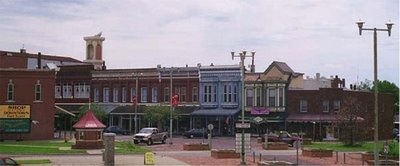FINANCIAL BENEFITS
Summary of financial benefits available to owners of "contributing" properties within the Hist. Dist. (as well as individually-listed properties).
Residential or Non-"Income-Producing" Property
I. Kansas Heritage Trust Fund (HTF) Grants
A. Up to 80% of approved project (see note below)
B. Up to $90K max.
C. Competitive
D. Almost never repeated
II. State Income Tax Credits
A. 25% of approved project (see note below)
B. No max. dollar limit
C. Non-Competitive
D. Can be taken repeatedly
E. Extra credits can be sold
Commercial or "Income-Producing" Property
I. Kansas Heritage Trust Fund (HTF) Grants
A. Max. percentage of approved project (see note below)
1. Up to 80%, if owner in individual
2. Up to 50%, if owner is corporation
3. $1:$1 match, if owner is a not-for-profit (501c3) corp
B. Up to $90K max.
C. Competitive
D. Almost never repeated
II. State Income Tax Credits
A. 25% of approved project (see note below)
B. No max. dollar limit
C. Non-Competitive
D. Can be taken repeatedly
E. Extra credits can be sold
III. Federal Income Tax Credits
A. 10%-20% of approved project (see note below)
B. No max. dollar limit
C. Non-Competitive
D. May sometimes be taken repeatedly
E. Extra credits can not be sold
NOTES:
- Listing in the Registers makes a property owner eligible to apply for KHTF grants, but it does not guarantee the grant will be awarded.
- With both grants and tax credits, the restoration project must be approved in advance and restoration guidelines must be followed & documented.
- The Federal Tax Credit program is structured to benefit those whose restoration project costs many times over what they paid for building as it is designed to encourage people to save historic buildings from the wrecking ball, buy condemned properties, etc. (e.g. buying a building for $1 at a Sheriff’s sale, then investing $100K in the restoration).
Summary of financial benefits available to owners of "contributing" properties within the Hist. Dist. (as well as individually-listed properties).
Residential or Non-"Income-Producing" Property
I. Kansas Heritage Trust Fund (HTF) Grants
A. Up to 80% of approved project (see note below)
B. Up to $90K max.
C. Competitive
D. Almost never repeated
II. State Income Tax Credits
A. 25% of approved project (see note below)
B. No max. dollar limit
C. Non-Competitive
D. Can be taken repeatedly
E. Extra credits can be sold
Commercial or "Income-Producing" Property
I. Kansas Heritage Trust Fund (HTF) Grants
A. Max. percentage of approved project (see note below)
1. Up to 80%, if owner in individual
2. Up to 50%, if owner is corporation
3. $1:$1 match, if owner is a not-for-profit (501c3) corp
B. Up to $90K max.
C. Competitive
D. Almost never repeated
II. State Income Tax Credits
A. 25% of approved project (see note below)
B. No max. dollar limit
C. Non-Competitive
D. Can be taken repeatedly
E. Extra credits can be sold
III. Federal Income Tax Credits
A. 10%-20% of approved project (see note below)
B. No max. dollar limit
C. Non-Competitive
D. May sometimes be taken repeatedly
E. Extra credits can not be sold
NOTES:
- Listing in the Registers makes a property owner eligible to apply for KHTF grants, but it does not guarantee the grant will be awarded.
- With both grants and tax credits, the restoration project must be approved in advance and restoration guidelines must be followed & documented.
- The Federal Tax Credit program is structured to benefit those whose restoration project costs many times over what they paid for building as it is designed to encourage people to save historic buildings from the wrecking ball, buy condemned properties, etc. (e.g. buying a building for $1 at a Sheriff’s sale, then investing $100K in the restoration).


